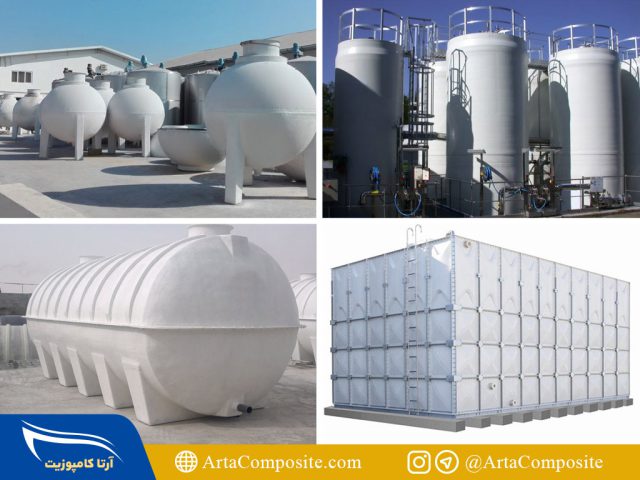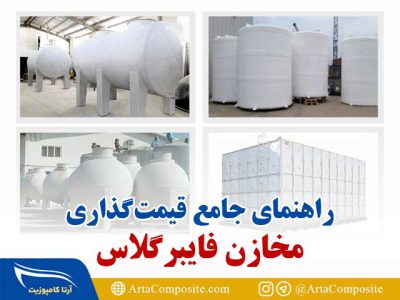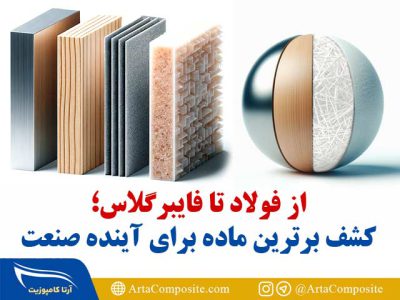A comprehensive guide to the steps of making fiberglass tanks

A comprehensive guide to the steps of making fiberglass tanks
Introduction: Fiberglass tanks are of great importance due to their unique features and wide applications. These tanks, which are made from a combination of glass fibers and polymer resins, have a high resistance to corrosion, chemicals and atmospheric changes, which makes them ideal for storing chemicals, water, sewage and other liquids in various environmental conditions. Their light weight and customizability allow for easy installation and transportation. In addition, the thermal and electrical insulation of fiberglass makes these tanks very useful in environments where there is a need for temperature control or protection against electrical current. High life span and low need for maintenance make these tanks an economical and efficient option in many industries. In this article, we have presented the manufacturing steps of fiberglass tanks comprehensively and completely.
Building fiberglass tanks usually involves a few key steps:
1-Design and planning
The first step in making fiberglass tanks is design and planning. In this step, the size, shape and specific characteristics of the tank are determined. Also, raw materials and necessary processes for production are selected based on customer needs.
Due to flexibility in design and construction, fiberglass tanks can be produced in various shapes and with special features. Here are some of the most common types of shapes and the special features of each:
a) Cylindrical tanks: These types of tanks are cylindrical in shape and are used to store different liquids. are being used. Cylindrical tanks can be designed horizontally or vertically. Vertical tanks usually take up less space, while horizontal tanks are more suitable for locations with height restrictions.
b) Cubic or rectangular tanks: These types of tanks are for limited spaces that require maximum The use of space is appropriate. They can be designed to fit easily into corners or under structures.
c) Tanks with custom shapes: Fiberglass makes it possible to make tanks with special and custom shapes Provide. This can include curved, angled designs or any other special shape to suit a specific environment or specific needs.

2- Template preparation
Molds are used to shape fiberglass. At this stage of fiberglass tank construction, molds can be made of various materials such as steel or plastic and must be carefully prepared and polished so that their inner surface is smooth and flawless.
The preparation of molds for making fiberglass tanks is a precise and important process, which can be made of fiberglass or steel or other materials. In this article, the manufacturing steps are described. -% b3/" class="st_tag internal_tag" rel="tag" title="Posts tagged with fiberglass mold" target="_self">Fiberglass and steel mold:
A) steps of making fiberglass molds:
- Mold design: First, a mold is designed based on the desired tank design. This design can be done using CAD software (computer-aided design) to achieve high accuracy in the dimensions and shape of the mold.
- Making a replica: Based on the design, a physical replica of the mold is made. This mock-up is usually made of materials such as wood, foam or plastic and must exactly match the dimensions and final shape of the tank.
- Making the replica: The replica must be carefully polished to have a smooth and flawless surface. Any unevenness on the surface of the model can affect the final quality of the mold and tank.
- Making the mold: After preparing the mockup, the main mold is made. This is usually done using materials such as fiberglass or special resins. Fiberglass and resin layers are placed on the model to create a strong and accurate mold based on the shape of the model.
- Drying and hardening of the mold: The mold should have enough time to dry and harden. During this time, the structure of fiberglass and resin is strengthened and the mold reaches the necessary strength.
- Separation of the mold from the replica: After complete hardening, the mold is separated from the replica. This should be done slowly and carefully so as not to damage the mold.
- Finalization of the mold: Finally, the mold must be prepared for final use. This includes smoothing out any unevenness in the surface and making sure it is smooth and flawless. Sometimes it may be necessary to coat the mold with a release agent or wax to make it easier to separate the tank from the mold in the future.
These processes demonstrate the importance of precision and attention to detail in the manufacture of fiberglass molds, as the quality of the mold directly affects the final quality of the tank.
b) Steps of making steel molds:
The manufacture of steel molds, which are often used to produce high-precision and high-strength industrial parts, involves several precise and complex steps:
- Mold Design: As with fiberglass mold making, the first step is mold design. This design is usually done using computer-aided design (CAD) software to ensure that all details and dimensions are met with high precision.
- Material selection: Suitable steel is selected for mold making. This selection is based on required properties such as hardness, wear resistance, and heat tolerance.
- Steel cutting and shaping: Steel is cut to the basic dimensions and shapes required for the mold. This can be done using methods such as laser cutting, plasma, or milling.
- Precision Machining and Milling: After initial cutting, the steel parts are machined by (CNC) machines to achieve very high precision and precise dimensions.
- Hardening and heat finishing: To increase the strength and durability of the mold, the steel may be subjected to heat finishing processes such as hardening or annealing.
- Surface finishing: Mold surfaces must be smoothed and polished carefully to avoid any unevenness and errors in the manufactured parts. This can include fine grinding and polishing.
- Mould assembly: Finally, all the mold parts are assembled. This step may include the installation of cooling systems, injection channels, and other mechanical components.
- Testing and final adjustments: After assembly, the mold may be tested to ensure that all parts are working properly. Necessary adjustments are made to improve accuracy and efficiency.
Making steel molds requires high engineering skills and extreme precision, because the quality of the mold directly affects the quality and accuracy of the manufactured parts. These molds are widely used in the production of auto parts, tools, and other industrial parts.

3- Layering and matting
At this stage of the fiberglass tank manufacturing process, layers of glass fibers and resin are placed on the mold. This may be done manually or using mechanized methods. Layers must be carefully placed and trapped air must be removed to avoid air bubbles.
A) mechanized method:
In the mechanized manufacturing process of fiberglass tanks, "Chappergan machine" is an important and advanced technique for placing glass fibers and resin. This method is especially used for mass production with high precision. Here we explain this method:
Using the chopper machine:
Chapergan machine method is a special technique in mechanized layering, in which glass fibers are crushed by a machine (Chapergan) and simultaneously sprayed with resin on the mold. In this method, glass fibers are sprayed to the surface of the mold through a nozzle along with resin. This process helps to create a strong and uniform layer and allows better control of thickness and composition of materials.
In this method, precise control over the amount and proportion of fibers and resin is important, because these factors directly affect the mechanical properties and final durability of the product. The use of mechanized techniques is very effective, especially in industrial productions that require high precision and repeatability.

b) traditional method or screw layer:
The manual method of laying fiberglass, which is sometimes known as "hand lay-up" or "hand lay-up", is one of the most traditional and widely used methods for making fiberglass tanks and parts. This process includes the following steps:
Cutting of glass fibers: Glass fibers in the form of fiberglass mats or braids are cut to the required sizes to be placed on the mold.
Resin Application: The resin, usually a polyester, epoxy, or vinyl ester, is brushed directly onto the mold or onto the fiberglass layers.
Placing glass fibers on the mold: Layers of glass fibers are placed on the mold and covered with resin. At this stage, the air trapped between the layers should be removed by rollers or brushes to prevent the formation of air bubbles.
Layering repetition: This process (laying fibers and resin) is repeated as many layers as needed. The final thickness of the product depends on the number and thickness of glass fiber layers.
The manual method of laying fiberglass is still popular in many workshops and smaller projects due to its flexibility, precise control over the production process, and less need for advanced equipment. This method is especially suitable for producing parts with complex shapes or small volume productions.

4- Drying and hardening:
The fourth step in the process of making fiberglass tanks is to dry and harden the product, after the layers of fiberglass are placed, it should be given enough time to dry and harden. This process may take several hours or even days.
Drying and hardening of fiberglass tanks made by processes such as manual or mechanized lamination is a critical step in production. The environmental conditions for this process must be carefully controlled to ensure that the resin dries and hardens properly. Here are some of these conditions:
- Environmental temperature: The ambient temperature for resin drying and hardening should be within the range recommended by the resin manufacturer. Usually, the ideal temperature is between 15 and 25 degrees Celsius. Temperatures that are too low can slow down the curing process, while temperatures that are too high may cause the resin to dry too quickly and cause cracking or surface roughness.
- Environmental humidity: High humidity can affect the curing properties of the resin and sometimes cause the surface of the finished product to remain sticky or uneven. It is better to keep the humidity of the environment at an average level.
- Proper ventilation: Good ventilation in the drying space is important, especially to remove fumes from the resins, which can be toxic. Also, proper ventilation helps regulate temperature and humidity.
- Drying time: The time required for complete drying and hardening depends on the type of resin, the thickness of the layers and the environmental conditions. This period can vary from a few hours to a few days.
- No agitation or vibration: During the drying process, it is important that the mold and the finished product are not subjected to vibration or agitation, as this can negatively affect surface quality and structural integrity.
- Post-treatment processes: In some cases, post-treatment processes such as kiln firing may be used to accelerate and improve the drying and hardening process.
Compliance with these conditions ensures that fiberglass tanks are produced with high quality and favorable mechanical properties.
5- Completion and final payment
After complete drying, the tank is removed from the mold. At this point, cuts may be required to create openings, install fittings, or make other modifications. Also, the surface of the tank can be polished to have a smooth and uniform appearance.
Finishing and finishing is a key step in the fiberglass tank manufacturing process that contributes to the beauty, functionality and durability of the final product. This stage includes several important processes:
- Shearing and Cutting: First, any burrs or excess sections of fiberglass created during the manufacturing process are removed. This is usually done using cutting tools such as saws or manual or electric sanders.
- Sanding: After cutting, the surface of the tank is carefully sanded to make it smooth and uniform. This will also help remove any bumps or air bubbles.
- Surface treatment: To improve the appearance of the tank and increase its durability against environmental factors, it may be necessary to cover the surface of the tank with special materials such as protective resins or varnish.
- Painting: In many cases, fiberglass tanks are painted for better UV and weather resistance or for added aesthetics. Color selection is usually based on tank application and customer preference.
- Installing fittings and accessories: The final step involves installing any fittings or accessories such as valves, stands or other mechanical components that are necessary for the tank to function.
- Final Quality Control: After completion of all steps, a final inspection is performed to ensure that the tank meets the desired quality standards and technical specifications in all aspects.
These completion and final payment steps guarantee that Fiberglass tank not only has a good performance, but also has a good appearance and high resistance against external factors. These processes can also help extend the life of the tank and reduce the need for future maintenance
6- Inspection and testing
The last step in the process of making fiberglass tanks; Finally, the tank must be inspected and tested to ensure it meets quality and safety standards. Inspection and testing of fiberglass tanks after construction are critical steps that ensure the final product meets quality and safety standards. These processes include several different tests and inspections:
- Visual Inspection: This is the first and foremost step where the tank surface is carefully inspected for any defects such as cracks, air bubbles, surface roughness or visual weaknesses.
- Pressure Testing: Fiberglass tanks are usually pressure tested to ensure they can withstand the desired pressure and to prevent leaks. This test involves filling the tank with water or compressed air and applying pressure to a certain level.
- Wall thickness test: To ensure that the thickness of the tank walls at all points is in accordance with the design specifications, thickness measuring devices such as electromagnetic or ultrasonic can be used.
- Non-destructive testing: Methods such as ultrasonic testing, radiography or leak testing can be used to identify internal weaknesses such as cracks or internal voids.
- Chemical resistance testing: If the tank is used to store chemicals, tests may be performed to evaluate the tank's resistance to corrosion or the effects of certain chemicals.
- Thermal testing: In some cases, it may be necessary to expose the tank to high or low temperatures to ensure that it performs well in different environmental conditions.
- Inspection of fittings and accessories: All fittings, valves and other components connected to the tank should be inspected to ensure proper installation and no leaks.
After the tank has successfully passed all these tests and inspections, it will be ready to use in its application environment. These inspection and testing processes not only help ensure the safety and efficiency of the tank, but also ensure that the tank is reliable over a long period of time and under various operating conditions.
These steps can vary depending on the size, shape and specific application of the tank. Also, new technologies and materials may make changes in the manufacturing process.
Finally, we would like to introduce to you, Fajar Sablan Entrepreneurs' Cooperative Company (Arta Composite); With more than a decade of experience, using experienced staff and experienced engineers, we are ready to implement your ideas and designs in the construction of fiberglass tanks in different types and styles. To communicate with us, you can contact us through the present website. It means "Arta Composite" and communicate with the company's supporters.
Translator and compiler: Mohammad Hassan Jafari



